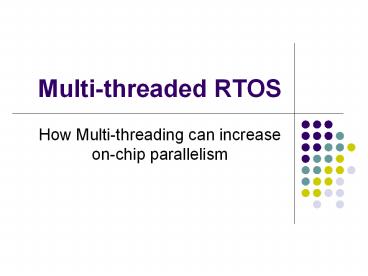Multi-threaded RTOS - PowerPoint PPT Presentation
Title:
Multi-threaded RTOS
Description:
Data separate date memory space - Thread- multiple functional units ... Only one thread issues instructions each cycle, but it can use the entire issue ... – PowerPoint PPT presentation
Number of Views:264
Avg rating:3.0/5.0
Title: Multi-threaded RTOS
1
Multi-threaded RTOS
- How Multi-threading can increase on-chip
parallelism
2
Outline
- Introduction
- Multi-threading models
- Architectures of multi-threaded processors
- Simultaneous multi-threading and multi-processors
- Cache design
- Examples of Multi-threaded environments
- Conclusions
3
Introduction
- Two forms of parallelism
- instruction-level parallelism (ILP)
- thread-level parallelism (TLP)
- Both identify independent instructions that can
execute in parallel - Wide-issue superscalar processors exploit ILP by
executing multiple instructions from a single
program in a single cycle. - Multiprocessors exploit TLP by executing
different threads in parallel on different
processors. - The first multi-threaded processor approaches in
the 1970s and 1980s applied multi-threading at
user-thread-level to solve the memory access
latency problem.
4
Introduction
- Motivations for multi-threaded processor
architecture development include chip area , cost
and complexity. - Simultaneous Multi-threading (SMT),
- Single chip multiprocessing (CMP),
- SMT VLIW architecture,
- Multithreaded Vector (SMV) architecture
- DSP applications inherently benefit from the
following architectural characteristics - Parallelization at multiple levels of hierarchy
- - Instruction - separate instruction memory space
- - Data separate date memory space
- - Thread- multiple functional units
- - Data transfer multiple wide data buses
5
Vertical and Horizontal Waste
- Vertical waste is introduced when the processor
issues no instructions in a cycle - Horizontal waste when not all issue slots can be
filled in a cycle.
6
Vertical and Horizontal Waste
7
Multi-threaded Models
- Fine-Grain Multithreading
- Only one thread issues instructions each cycle,
but it can use the entire issue width of the
processor. - SM full Simultaneous Issue
- Single
- Dual
- Four
- SM limited Connection
- Hardware context is connected directly one of
each type of functional units. - Less dynamic
8
Performance
9
SMT VLIW Architecture
10
Simultaneous Vector Multi-threaded Architecture
(SVMT)
11
SMT vs. Multiprocessing
12
Cache design
13
Examples Multi-threaded RTOS
- Analog Devices VDK
- uClinux
- The RTXC Quadros RTOS
- RTCX/ss
- RTXC/ss
- ThreadX
14
Conclusions
- A simultaneous multithreaded architecture is
superior in performance to a multiple-issue
multiprocessor (multi-issue CMP). - SMT boost utilization by dynamically scheduling
functional units among multiple threads. - SMT also increases hardware design flexibility.
- Simultaneous multithreading increases the
complexity of instruction scheduling. - Increased parallelism offered makes
multi-threading ideal for DSP applications where
each application can run as a separate thread.































